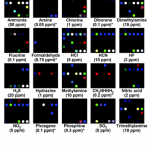color
"I found I could say things with color and shapes that I couldn't say any other way -- things I had no words for." -Georgia O'Keeffe
When it comes to the Universe, it isn't just the stuff that's in it that's important.
Image credit: 2MASS Extended Source Catalog (XSC).
It's also how all that stuff interacts with itself and everything else. To the best of our knowledge, there are four fundamental forces in the Universe, and they're all essential to our existence.
Image credit: Stichting Maharishi University of Management, the Netherlands.
Some of them are familiar, like gravitation. On the…
We can babble philosophically about whether or not what we call "red" looks the same from another person's eyes, we can compare the adjectives we use to specify colors--is it maraschino red or cayenne?--but when we're talking to our computers, categorizing flowers, designing objects for mass production, branding a company, or establishing a flag's official colors we have to be able to be specific about which exact shade of red we want.
These days we have standard color systems that define colors as specified mixes of red, green, and blue pixels on screen, specific mixtures of pigments in…
Yes, green laser pointers are cool. Especially when you use them to make stuff fluoresce. Ok, what about a blue laser pointer? They are getting surprisingly cheap (Amazon has a 10 mW for pretty cheap). Still not cheap enough for me. But, you know what? Some of the physics majors here at Southeastern Louisiana University purchased a couple of these. Physics major Daniel let me borrow his.
First, they don't look too bright. This is probably because our eyes are not too sensitive to this wavelength. The blue 10 mW does not look anywhere near as bright as the 5 mW green that I used in…
So you have seen these color filters (or gels as they are also called). When you look through a red filter, everything looks red. What do they do to the light? I am not going to tell you the answer. However, I will show you some examples so that you can figure out the answer yourself.
In this video, I am going to use a red and a green laser pointer. The nice thing about laser pointers is that they essentially create only one color of light.
When you look at yourself from a universal standpoint, something inside always reminds or informs you that there are bigger and better things to worry about.
-Albert Einstein
I woke up this morning with the Sun in my face, which marks the first time all year that that's happened.
(The irony, that I'm now listening to the Grateful Dead's "Looks Like Rain.")
And after a few seconds had passed (you know, it takes me a few seconds to realize that I'm not still in my dream, trying to navigate through some bizarre hotel corridor), I realized I couldn't read the numbers on my old LED alarm clock.…
Researchers at the University of Illinois, Urbana-Champaign have developed a way to compare aromas visually using specially developed inks.
Kenneth Suslick and his colleagues used tiny squares of polymer film that hold 36 drops of carefully designed dyes. These pigments change colour when exposed to various chemicals. The result is a cheap system for detecting very low concentrations of gaseous compounds. The cards can be used like a physicist's radiation dose badge to alert lab workers when they have been exposed to toxic gases.
As shown above, the cards can be used to give each…
Do you have a green laser pointer? You should. They are relatively inexpensive now. What if you take your laser pointer and aim it at stuff in your house? The laser dot always looks green, right? This is actually a pretty important point about color. Suppose I have the lights on in a room and I look at a blue book. White light is basically all the colors of the visible spectrum, so a diagram like this might be appropriate:
So, the book looks blue (since that is what your eye sees). Note that I just showed blue light coming off the book, really the other colors reflect some too but…
tags: evolutionary biology, paleontology, taphonomy, plumage color, feathers, color, melanin, eumelanin, phaeomelanin, dinosaurs, theropod, paravian, avialae, fossils, Anchiornis huxleyi, ornithology, birds, researchblogging.org,peer-reviewed research, peer-reviewed paper
New research reveals that recently-described 155-million-year-old Anchiornis huxleyi,
a woodpecker-like dinosaur the size of a modern-day domesticated chicken,
had black-and-white spangled wings and a rusty red crown.
Image: Michael DiGiorgio, Yale University [larger view]
Fig. 4. Reconstruction of the plumage color of…
National Geographic should have a 3-D animation up soon
The pursuit of accurate dinosaur colours just turned into a race, and a heated one at that. Just last week, I wrote about a group of scientists who claimed to have accurately identified the colours of some feathered dinosaurs by microscopically analysing three fossils. According to that study, Sinosauropteryx had a tail covered in ginger stripes. Now, another group have revealed the palette of an entire dinosaur, Anchiornis. This tiny predator had a dark grey body and the limbs bore long, white feathers tipped with black spangles. Its…
tags: evolutionary biology, fossils, feathers, plumage color, color, dinosaurs, theropods, Sinosauropteryx, Sinornithosaurus, birds, Confuciusornis, melanosomes, phaeomelanosomes, eumelanosomes, keratinocytes, SEM, scanning electron microscopy, 10.1038/nature08740, researchblogging.org, peer-reviewed research, peer-reviewed paper
Reconstruction of two Sinosauropteryx, sporting their orange and white striped tails.
Artwork by Chuang Zhao and Lida Xing [larger view]
DOI: 10.1038/nature08740
While looking at museum dioramas that feature dinosaurs, I often overhear people asking "How do they…
Yes, this can be very complicated. But what should a middle-school student understand about light? You see stuff in textbooks that is either wrong or just a bunch of disconnected factoids (I like the word factoid). So, what do I think is important about light (not at the Maxwell's equations level)
What is a wave
If you want to talk about light, you need to talk about waves. So what is a wave? I like to start with an example. Suppose you are in a sports stadium - maybe a football game. Some inspired fan decides to start a wave. If you look at the individual people, the wave might be…
This comes up everytime I teach physics for elementary education majors. The curriculum I use (Physics for Everyday Thinking - which is awesome) says that the colors in white light are ROYGBV (Red-Orange-Yellow-Green-Blue-Violet). Typically, I will get a student that says "Hey! What about indigo? Shouldn't it be ROYGBIV?" My first reaction to this was "huh?" Really, does it matter? Here is the spectrum you would see looking at a white light source.
You could break this into as many or as few colors as you like. So, it doesn't really matter. But this leads to a great question: Who…
What do you see when you are in a completely dark room with no lights?
That is a great question to ask. It can bring out some interesting ideas. Anyway, here is an easy demo to show the color black. The basic idea is to build a box that has a small opening. Here is what it looks like from the outside:
As you can see, just a basic box. I have a door on the top, and I put a paper towel tube for a window. To make it look pretty, I covered it with black paper (so you couldn't tell where I stole the box from).
To demo this to students, I first go around and let everyone look inside. I ask…
Having trouble with a word puzzle? Suffering from writer's block? Perhaps you're not looking at the right colour...
We encounter many of the colours in our lives under the same circumstances and as a result, we have come to associate certain colours with specific attributes. Red invokes thoughts of action, danger or mistakes because it is a common feature of warning signs and editorial ink. Blue, however, is a more soothing hue, and its presence in both sky and sea have connected it to peace and openness.
These associations aren't trivial ones - they can affect the way we think. In a clever…
My kids like books. Especially when they are going to bed. I let my daughter pick a book and she picked "Clam-I-am. All About the BEACH" by Trish Rabe. It is nice, it rhymes. The pictures are pretty. Then I get to this page:

So, the ocean is blue because of the sky? How do you get green oceans? How about brown (I live in Louisiana, trust me - the gulf of Mexico can be brown)? What about when you are underwater, everything looks blue. The best answer to why the ocean is blue is that that is what color does…
Fascinating video from the PBS special, Dogs that Changed the World, on the changes that took place when foxes were bred for tameness in the former Soviet Union. This was originally posted on Greg Laden's Blog but I had to repost it here.



